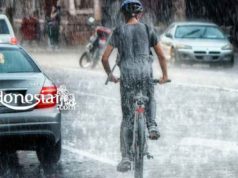Sukabumi is an area in Indonesia which is very famous for its fast flowing rivers. One of them is the Citarik River which has become an icon of special interest tourism, namely the adventure of conquering the swift currents of the river, known as rafting.
Citarik is a tributary of the Cimandiri River which originates from a forest area at the foot of Halimun, part of the Mount Halimun-Salak National Park (TNGHS). Flowing 44 kilometers, the Citarik stream empties into Pelabuhanratu.
The river’s swift currents have been recognized worldwide and are certified with moderate to extreme difficulty (grades 3-5) from the International Rafting Federation (IRF). This location is declared suitable for rafting sports arena. Even on 29 November to 8 December 2015, the World Rafting Championship was held in Citarik followed by 400 participants from 23 countries.
How do tourists reach Citarik? Don’t worry, you can reach it from Jakarta by land trip for 3-5 hours with a route of steep climbs and descents with views of the mountains, oil palm plantations, teak, and sengon.
There are several rafting operators operating in Citarik and they offer almost uniform tour packages with costs ranging from IDR 230,000 to IDR 375,000 for a single trip.
There are packages within 5 to 9 kilometers (km) with a travel time of 1-2 hours and packages 12-22 km lasting 3-7 hours. The package includes insurance, certificate, lunch, and free coconut water.
Don’t be afraid of drowning
This activity should be done in groups of at least five people. Early morning is the best time to start rafting. Kampung Parakan Telu and Kampung Pajagan in Cigelong Village are usually the starting points (put in) of rafting. While the end point (take out) is usually Citangkalo Village for the 5-9 km route or Cikadu Village, Pelabuhanratu, for the 12-17 km route.
Free transportation is provided to reach the put in location. Vehicles cannot enter the river bank. We have to walk past the rice fields, ponds, and residents’ villages and down steep paths.
Each participant must wear standard rafting equipment such as life jackets and protective helmets according to body size and paddle. Everything has been prepared by the operator. Don’t forget to deposit valuables such as a wallet or cellphone at the luggage storage. If we wear glasses, it is advisable to equip it with special straps. Use casual clothes when rafting and prepare a change of clothes.
Before taking action on the river, the guide (skipper) will give instructions to the participants, such as how to row properly, sitting in the boat, and cues when they meet rafting.
For example, when the guide shouts boom, then all participants must be alert because they will enter the rapids with high difficulty or danger. The guides are generally local residents who have pocketed international rescue certificates. Not a few of them are professional rafting athletes. Each boat has a capacity of 7-8 people including a guide and generally sits at the back. They serve as leaders to control the speed of the boat.
There is a rope around the outer edge of the boat. The name is a chicken line and is useful as a place to hold the hands of participants if they fall or the boat capsizes when passing through the rapids. For those who can’t swim don’t be afraid of drowning because we are wearing a life jacket. When plunged into the water and a position a little far from the boat, even though it is carried away while waiting for the help of the guide, try to keep your head on the surface of the water and your feet to keep floating forward following the flow of the water.
As long as the life jacket is still attached to the body and always heed the instructions of the guide, we can still enjoy the fun of rafting.
Golden Gate rapids
Citarik has several famous rapids and is given unique names based on events that have occurred at that location. There are Ayu, Teureup, Guntur, and Rock Brick Jeram which can be passed easily because the water current is moderate.
The new fun begins at Jeram Nipah, Big Wave, Paint Ball, and Jeram Circuit. Because the water discharge starts to feel heavy in the presence of large rocks which create whirlpools. Furthermore, there is a rafting named TVRI because there used to be a TVRI camera journalist who fell unconscious while rafting at that location.
Next up is the Golden Gate Rapids. These rapids are flanked by large rocks at a glance like a gate or gate. To get through the rapids in the middle is quite difficult because the available space is very narrow. More often than not, boats capsize on this rapids. If a guide is able to carry the boat without tipping over the rapids, they usually get some sort of gold point.
There are still Zig Zag rapids and Big Z rapids, which require us to pass through them by snaking because of the swift currents of water and often hitting the large rocks around them. Other types of rapids are Long Jeram, Walk Away Jeram, and Jumping Jack Flash Jeram.
It should not be forgotten that there are also attractive natural scenery that stretches out on either side of the river during rafting. Green trees and lush bamboo and rice fields accompany our journey in Citarik. Not infrequently we meet lizards swimming or sunbathing on the rocks. Come on, make Indonesia the best tourist destination for you and get interesting information only from Indonesiar.com.































